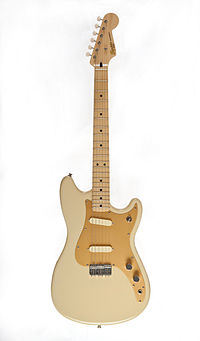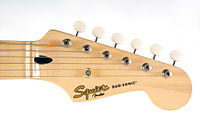- Fender Duo-Sonic
-
Fender Duo-Sonic 
Manufacturer Fender Period 1956-1969, 1994-1999, 2008-present Construction Body type Solid Neck joint Bolt-on Scale 22.5" or 24" Woods Body Ash, Alder or Basswood Neck Maple Fretboard Maple or Rosewood Hardware Bridge fixed Pickup(s) 2 "vintage style" single coil Colors available Desert Sand, Sunburst (sometimes called maroonburst), Sonic Blue, Dakota Red, Black, Torino Red, Arctic White The Fender Duo-Sonic guitar was launched by Fender as a “student” model guitar. The “Duo-Sonic” features two single-coil pick-ups and a vertical (as opposed to Fender's standard blade-style) switch on the lower horn of the body to select bridge, neck or both pickups in a humbucking style configuration. The Duo-Sonic features typical Fender construction techniques with a bolt-on neck, maple attached to a solid body. The bridge is fixed and the line has a shorter scale neck than standard models as a concession to younger, beginner guitarists and other players with smaller hands.
Contents
Original design (1956-1959)
The Fender Duo-Sonic was introduced in 1956. Like the Musicmaster introduced a few months earlier, it featured basic but effective construction and a 22.5 inch scale length (standard Fender guitars feature a 25.5 inch scale) and cost $149.50. The original model was only available in a light tan color called Desert Sand and had a maple fingerboard with 20 frets and a neck with a soft-V profile. The original model Duo-Sonics also sport a gold-colored, anodized scratch plate that helps in screening the single-coil pickups and electronics from interference.
Second version (1959-1964)
In 1959 the Duo-Sonic went through a face lift. The most significant change was a switch from a maple finger board to a rosewood one in keeping with changes to other Fender models at this time. These fret boards were originally in the slab-style but switched to the veneer style after approximately a year. The other significant change was a switch from anodized aluminum to plastic pickguards. To begin with the second generation Duo-Sonic was still only available in Desert Sand, however, the tan color now used was significantly darker than that used on the 1956-59 models. In 1961 a new color, sunburst, was made available; this color is sometimes referred to as maroonburst for the way it looks today. In mid-1961 the Desert Sand color was dropped and then in mid-1963 Sunburst dropped and replaced by white.
Third version - Duo-Sonic II (1964-1968)
In 1964 the Duo-Sonic was redesigned based on the Fender Mustang that had recently been added to the student model line but without the vibrato tail-piece. The student guitars now all featured larger and slightly offset bodies, necks with larger headstocks and rosewood fingerboards and plastic pickguards with the volume and tone controls mounted on a separate metal plate. Pick-up selection was moved above the pick-ups on both the Duo-Sonic and the Mustang and utilized two 3-position on-off-on switches that allowed for in and out-of-phase sounds. The pickups were also reverse-wound/reverse-polarity, which made them into a functional Humbucker when both pick-ups were used simultaneously. Also added in this redesign was the option of a 24 inch scale neck in addition to the 22.5 inch scale. This re-designed model was re-named Duo-Sonic II although decals with and without the II designation were used occasionally. In addition to white, Sonic Blue and Dakota Red colors added.
The Duo-Sonic lasted until 1969 when it was dropped most likely because the Mustang with its tremolo tail piece was far more popular.
The Duo-Sonic I and II are both considered rare and have displayed growing collector value. The Duo-Sonic II in particular is often seen as a desirable alternative to the more popular Mustang, since it lacks the difficult-to-maintain tremolo bridge.
Reissues
In 1993 Fender released a Mexican-made reissue Duo-Sonic in a 22.7" scale. It was available in black, torino red and arctic white and cost $259.99. It was dropped from the Fender line in 1997 but was then launched again as a Chinese made Squier Affinity model in 1998 only to be dropped in 1999.
In 2008, the Duo-Sonic was re-released by Fender's Squier brand in the Classic Vibe series of guitars. It is intended to be closely modeled after the model released in the 1950s and looks very similar with a maple fret-board, gold pick-guard and Desert Sand body. Difference include the material used for the body is now basswood, the neck is now a 24" scale and is C-shaped with more modern medium jumbo frets.
Notable Duo Sonic players
- David Byrne - of Talking Heads early in his career
- Jimi Hendrix - played a Duo-Sonic when he backed up The Isley Brothers in the early 1960s and was known as Jimmy James, also in the studio in the mid-1960s, and while gigging with Curtis Knight & the Squires (New York, late 1965).
- John McLaughlin - before switching to a Gibson doubleneck in 1971.
- Johnny Winter - used a modified Duo-Sonic during the late 1960s and early 1970s, on his first few albums.
- Liz Phair - one of her main guitars is a now-faded white '60s Duo-Sonic.
- Patti Smith - plays a Duo-Sonic and has featured her guitar in song lyrics, for example in "Radio Ethiopia/Abyssinia" from the Radio Ethiopia LP.
- Dean Ween - Michael "Mickey" Melchiondo, Jr. of Ween plays a cherry-burst 60's Duo-Sonic/MusicMaster.
- Richard Lloyd and Tom Verlaine of Television.
- Rory Gallagher - used a Duo-Sonic guitar with MusicMaster neck that was tuned up one step circa 1982.
See also
- Fender Musicmaster for more history.
- Fender Mustang for more history of the Duo-Sonic II.
- Fender Bronco.
References
- Fender's 3/4 Scale Guitars, a two-part article by Tim Pershing in 20th Century Guitar Magazine, December 1996 and January 1997.
- Little Brothers Turn 50, an article by Terry Foster and Tim Pershing in Vintage Guitar Magazine, July 2006
- Fender: The Golden Age 1946-1970 by Martin Kelly, Terry Foster, Paul Kelly. London & New York: Cassell ISBN 1-844-03666-9
External links
- Fender's 3/4 Scale Guitars
- Musicmaster/Duo-Sonic Gallery
- shortscale.org Fender Shortscale Discussion Forum
- LITTLE BROTHERS TURN 50 by Terry Foster and Tim Pershing
- Fender: The Golden Age 1946-1970 Blog
Telecaster · Stratocaster · Jaguar · Mustang · Jazzmaster Electric guitars Minor modelsCoronado · Custom · Cyclone · Electric XII · Esquire · Jag-Stang · Katana · Lead Series · Marauder · Performer · Prodigy · Showmaster · Starcaster · ToronadoStudent modelsSteel guitarsAcoustic guitars Squier guitars See also Categories:- Fender electric guitars
Wikimedia Foundation. 2010.


